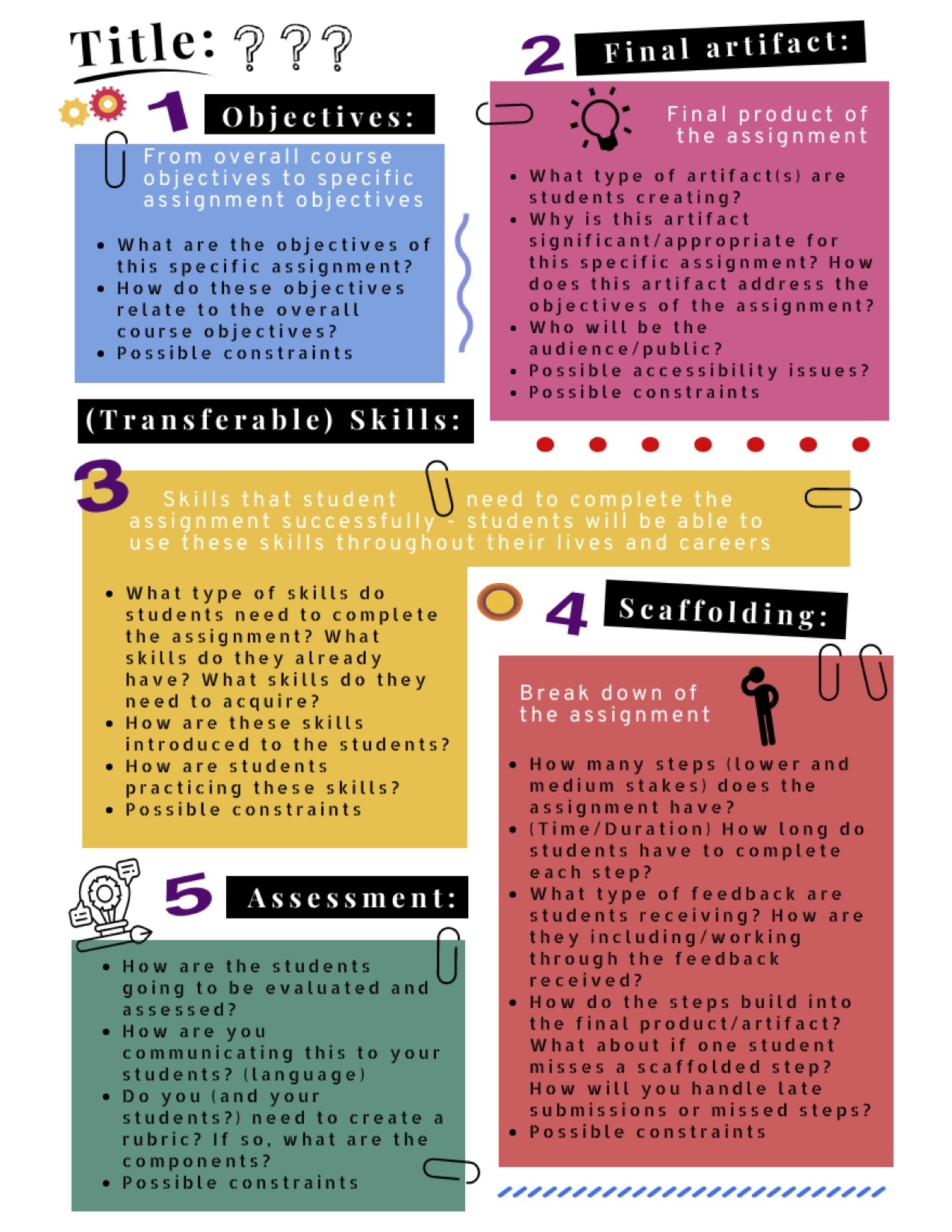Developed by Inés Vañó García
Description
Writing is a central aspect of academic life. As instructors, we regularly assign essays, compositions, proposals, annotated bibliographies, and final papers. There are, however, alternatives or accompaniments to these written assignments that may accomplish similar goals, or facilitate additional ones. Podcasts, zines, timelines, and other creative assignments allow students to produce artifacts with audiences beyond their instructor in mind, and to acquire knowledge, experience, and transferable skills that they can use throughout their lives and careers. These approaches also can invigorate the writing that students do in their courses and by allowing alternative paths to engage with course material, which may in turn facilitate deeper connections with our disciplines.
In this workshop, participants will review and explore several examples of alternatives or accompaniments to traditional assignments created by instructors in different disciplines. They will also have the opportunity to draft and receive feedback on a creative assignment for their own course.
Learning Goals
-
- Explore how creative assignment(s) (multimodal essays, zines, timelines, digital storytelling, among others) might fit your course and the skills students will need to accomplish it.
- (Re)frame, scaffold, and design an assignment, including its assessment and evaluation process.
Introduction
Many faculty envision the traditional written paper/essay as the formal product that students need to complete to achieve their academic potential. Final papers as a culminating semester project tend to work in limited ways; students share their work only to the teacher, who provides feedback and/or a grade. In some cases, students have the opportunity to build their final writing assignment with several low-stakes tasks during the semester, and implement the feedback they receive towards the final product.
Even when scaffolding is done during the semester, many written assignments usually do not see the light of the day outside the classroom. Creative, multi-modal assignments can give us the opportunity to expand teaching and learning beyond the classroom, positioning students as knowledge producers. These assignments can also have multiple pedagogical values by expanding the sense of audience, building and sustaining communities, and actively engaging students with advocacy work within their institutions and communities. Moreover, following an approach that fosters knowledge and inquiry, creative assignments are an alternative or accompaniment to traditional assignments and allow students to consider a broader audience, and engage with the public outside the classroom. By conducting public-facing projects (i.e. projects opened to an audience beyond the class community), students are also able to acquire new digital literacies and transferable skills that students can continue to use in other coursework and throughout their careers.
Questions to consider before exploring the examples/models:
-
- In your experience, what are the advantages and constraints/limitations of traditional writing assignments?
- What type of alternative and creative assignments do you envision in your courses? What are the advantages and constraints/limitations of these types of assignments?
Questions? Please share your questions, comments, concerns, and more with the rest of the participants through the “Reframing the final paper: Alternative & Creative Assignments” channel in the Institute’s Slack space.
Models
[Step 1]: Exploring some examples
Below is a list of creative assignments developed by faculty in different disciplines. Be aware that there is significant diversity among the assignments provided (semester-long public-facing projects, assignments along with the scaffolding and/or the written prompt, and final artifacts with no scaffolding or context). With this diversity, this list will give you the opportunity to explore alternatives to the traditional written assignments, rethink the advantages and limitations of the assignments we design, and inspire you with new ideas for your course.
These projects are organized by the type of artifact produced. Pick two or three of them to explore. Share your thoughts, comments, reactions by answering the following questionnaire for each example. Participants will have access to the excel sheet here with all the contributions.
Anthology:
“Choose your own adventure:”
(Digital) Storytelling:
Documentaries/Videos:
-
- Violence, healing, justice (site in progress)
Multimodal essays:
-
- Exploring Music (Fall 2019): Music and.. Playlist
- Digital Essay – Essay 4 in ENG 101: Mapping New York City
- Being Mexican and trying to get an Education in New York City (Course: SPAN 2204)
Story Maps:
-
- Minimalist: NYC’s Digital Infrastructure (minimalist – black and white)
- From the Upper West to the Brooklyn Bridge (Colorful map)
- New York City’s Infrastructure (Streetmap)
Timeline:
Zines:
Active Component
[Step 2] Let’s do this!
After exploring the different assignments, think about your course and your learning objectives. Now it is your turn to design your creative assignment! If it is the first time that you are teaching this class, you may want to start “small” (scope) and consider a way to complement your current written assignment(s), instead of replacing your final written assignment or creating a completely new full semester-long project.
The following table with questions will guide you through the process.
Questions? Please share your questions, comments, concerns, and final draft created using Google Docs with the rest of the participants through the “Reframing the final paper: Alternative & Creative Assignments” channel in the Institute’s Slack space.

Takeaways
By the end of this workshop, participants will
-
- Discuss the affordances and constraints of traditional writing assignments
- Discuss affordances and constraints of alternative creative assignments
- Examine and explore creative assignment models that accomplish the same objectives as traditional assignments
- Design a draft (low, medium or high stakes) assignment to be included in their course
- (Re)frame, scaffold, and design an assignment, including its assessment and evaluation process.

